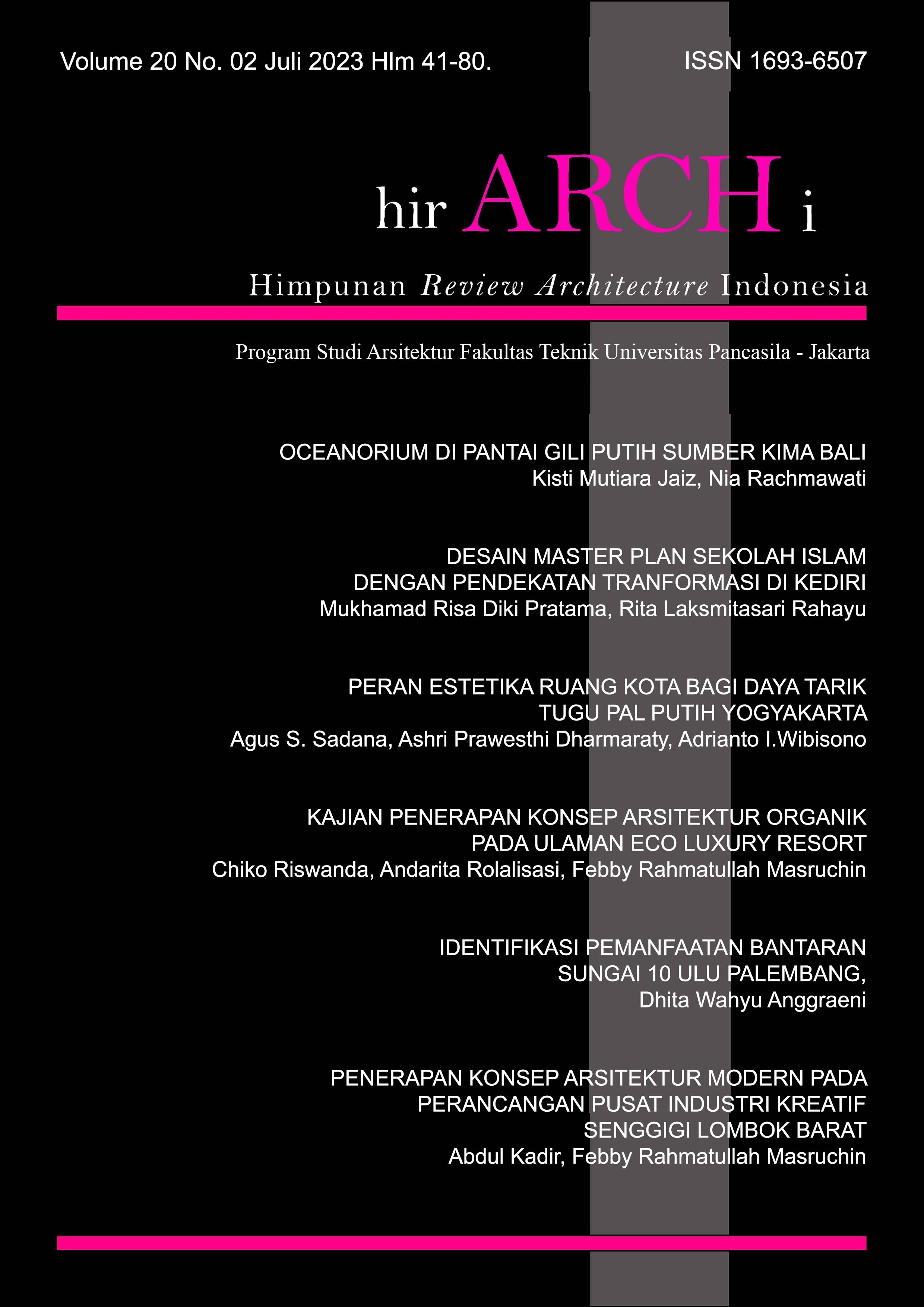KAJIAN PENERAPAN KONSEP ARSITEKTUR ORGANIK PADA ULAMAN ECO-LUXURY RESORT
Abstract
Its application through organic architectural theory is widely used in the design of outdoor spaces and interior spaces of buildings. One of the buildings that uses the concept of organic architecture is the Ulaman Eco-Luxury Resort building. In the opinion of some experts, the concept or approach of organic architecture is a design concept that is applied starting from the inside and outside of the building, selecting materials or building materials that are in accordance with natural characteristics, and uniting architectural elements into a single unit that has an expressive and dynamic style. This concept allows Ulaman Eco-Luxury Resort visitors to feel an atmosphere that can unite with nature comfortably. Buildings with this architecture emphasize harmony with nature, namely formations that follow the flow that exists in nature without opposing the workings of nature. The research method uses a qualitative descriptive method. The data collection technique used was a literature study related to the object of study being carried out. This information is then translated using the principles of organic architecture explained according to Pearson (2001) so as to give rise to the idea of applying the concept of organic architecture to the interior and exterior of buildings.
References
T. Rasikha, “Arsitektur Organik Kontemporer,” Tugas Akhir Dep. Arsit. Univ. Indones., hal. 103, 2009.
A. Setyoningrum dan A. Anisa, “Aplikasi Konsep Arsitektur Organik Pada Bangunan Pendidikan,” Langkau Betang J. Arsit., vol. 6, no. 1, hal. 26, 2019, doi: 10.26418/lantang.v6i1.32905.
M. Dudayev Aghniya dan Annisa, “Kajian Konsep Arsitektur Organik Pada Bangunan South Australian Health And Medical Research Institute / Woods Bagot,” J. UMJ, no. November, hal. 1–8, 2021, [Daring]. Tersedia pada: https://jurnal.umj.ac.id/index.php/semnastek/article/download/11472/6547
D. Pearson, New Organic Architecture, I. University of California Press, 2001.
H. Wahyuni dan S. Suranto, “Dampak Deforestasi Hutan Skala Besar terhadap Pemanasan Global di Indonesia,” JIIP J. Ilm. Ilmu Pemerintah., vol. 6, no. 1, hal. 148–162, 2021, doi: 10.14710/jiip.v6i1.10083.
S. P. Sujanra et al., “Penerapan Teori Arsitektur Organik,” 2009.
P. Steadman, The evolution of designs: Biological analogy in architecture and the applied arts. 2008. doi: 10.4324/9780203934272.
S. Lindawati, “Penggunaan Metode Deskriptif Kualitatif Untuk Analisis Strategi Pengembangan Kepariwisataan Kota Sibolga Provinsi Sumatera Utara,” Semin. Nas. APTIKOM (SEMNASTIKOM), Hotel Lomb. Raya Mataram, hal. 833–837, 2016.
S. B. Sihombing, “Resort Pemandian Alam Di Sipispis,” J. Ruang Luar dan Dalam, vol. 02, no. 02, 2022, [Daring]. Tersedia pada: http://ejurnal.istp.ac.id/index.php/jrld/article/view/133%0Ahttp://ejurnal.istp.ac.id/index.php/jrld/article/download/133/134
ArchDaily, “Ulaman Eco-Luxury Resort / Inspiral Architecture and Design Studios,” www.archdaily.com, 2022. https://www.archdaily.com/993318/ulaman-eco-luxury-resort-inspiral-architecture-and-design-studios
F. Fauzi dan W. Aqli, “Seminar Nasional Penelitian LPPM UMJ Website: http://jurnal.umj.ac.id/index.php/semnaslit E-Kajian Konsep Arsitektur Futuristik pada Bangunan Perkantoran”, [Daring]. Tersedia pada: http://www.streetdirectory.co.id/indonesi
Z. Angkasa, “Penerapan Konsep Arsitektur Rumah Panggung di Lingkungan Perkotaan,” Arsir, vol. 1, no. 2, hal. 175–183, 2017, [Daring]. Tersedia pada: https://jurnal.um-palembang.ac.id/arsir/article/view/880
A. Ridyasmara dan P. Wijayanto, “Konsep Arsitektur Organik pada Bangunan Penginapan Green Village Bali,” Pros. Semin. Intelekt. Muda #6, hal. 177–183, 2021.









